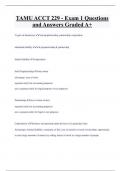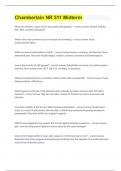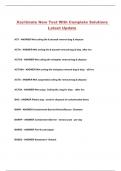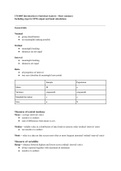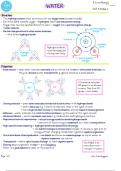A Level Biology
CARBOHYDRATES AQA Topic 1
• Carbohydrates contain carbon, hydrogen and oxygen, usually with the general formula CnH2nOn
Glucose
• A monosaccharide with the formula C6H12O6 Monosaccharides are small
soluble carbohydrate
• A hexose monosaccharide (six carbon atoms) in a ring structure
monomers. They also include
• Soluble in water → easily transported
fructose and galactose.
• Main energy source for animals and plants
→ chemical bonds store lots of energy
• Two isomers: α-glucose and β-glucose → H and OH groups on carbon 1 inverted in β-glucose
Displayed formula: Skeletal formula:
K0H glucose B-glucose
C11-2OH
a-
B-glucose
a-
glucose carbon
I
numbers
µ " "
-5C "
\ [
µ -0 c-
Hit H
, _ OH
[
4 '
OH HI '
H , OH HO
H GH H
'
OH
Glycosidic bonds and condensation/hydrolysis reactions
• Condensation reaction: two molecules join to form a new chemical bond and a water molecule is
eliminated
• Condensation reactions form glycosidic bonds between monosaccharides to create disaccharides and
polysaccharides
• Hydrolysis reaction: a water molecule is used and the chemical bond is broken (reverse of a
condensation reaction → breaks glycosidic bonds)
"
fHzOH FH20 polysaccharide with glycosidic bonds
"
'
÷
" " .
"
, '
o OH - ◦ -
↑ ↑
↓H'
H20 inserted H20 inserted
it
'
OH
FH20
"
f. HZOH FH20 µ ✓
hydrolysis reaction
,
q
H c- ° c- ◦
, /
, ,HH , / "
"
to
I 1
no "
OH
to OH
monoofaccharidesT.IO µ OH
GH glycosidic f GH
bond
Disaccharides
• Two monosaccharides joined together with a glycosidic bond in a condensation reaction
• Maltose = glucose + glucose
• Sucrose = glucose + fructose Monosaccharides and
• Lactose = glucose + galactose disaccharides are sugars.
Page 1 of 3 © Dr Zoë Huggett
, A Level Biology
CARBOHYDRATES AQA Topic 1
Polysaccharides
• Large polymers of monosaccharides joined with glycosidic bonds
• Starch and glycogen are large energy storage molecules which cannot leave cells
Starch Iodine test for starch
• Glucose storage in plants → hydrolysed when glucose is needed 1) Add iodine in potassium iodide
• Insoluble in water → does not affect the water potential of solution to sample.
cells so water is not drawn in by osmosis 2) If starch is present: goes from
• Amylose → unbranched α-glucose polysaccharide (1,4 glycosidic browny-orange to blue-black.
bonds)
→ helical structure so is compact amylose -
amylopectin
-
• Amylopectin → branched α-glucose polysaccharide (1,4 and 1,6
I
/
'
glycosidic bonds) ii. ÷ .
-
-
-
,
_
-
→ branches mean enzymes can easily access more /
I
✗
glucose
-
glycosidic bonds = faster glucose release 1
-
↓
I
-
.
-
.
,
_
Glycogen Cellulose
• Excess glucose storage in animals • Found in plant cell walls to give strength
→ easily hydrolysed when glucose is needed • Unbranched long and straight β-glucose polymers
• Insoluble in water → does not affect the (1,4 glycosidic bonds)
water potential of cells so water is not drawn • Chains linked with many hydrogen bonds to form
in by osmosis strong rigid microfibrils
• Highly branched α-glucose polysaccharide (1,4
hydrogen
- -
-
-
and 1,6 glycosidic bonds) → more ends so B- glucose i t ' " " -
bonds
→
. .
glucose can be released quickly by enzymes, i. i. i. i.
"
and it is compact
Benedict’s test for sugars
• Monosaccharides, maltose, and lactose are reducing sugars Colour of precipitate depends
• Sucrose is a non-reducing sugar on the concentration of
reducing sugars:
1) Add an excess of blue Benedict’s reagent to liquid food sample
in a test tube. Blue
2) Heat the tube in a water bath set to boil. t
3) If reducing sugars are present: coloured precipitate forms. Green
End test here.
4) If no reducing sugars are present: solution stays blue. Go to
step 5.
Yellow
:
5) Break down non-reducing sugars to monosaccharides: add dilute Orange
HCl to new sample and heat in a water bath set to boil. ↓
6) Neutralise with sodium hydrogencarbonate, then repeat steps Brick Red
1) and 2).
7) If coloured precipitate now forms, non-reducing sugars are You could filter, dry, and weigh
present in the sample. the precipitate to make more
8) If the solution is still blue, neither type of sugars are present. accurate comparisons.
Page 2 of 3 © Dr Zoë Huggett
, A Level Biology
CARBOHYDRATES AQA Topic 1
Using a colorimeter
• A more accurate and quantitative way to measure glucose concentration after the Benedict’s test
(judging colour is subjective and more affected by human error)
• When the precipitate is filtered out of the solution, the solution left is the Benedict’s reagent
→ more glucose = more precipitate = the less blue the remaining solution will be
• A colourimeter measures absorbance of light → lower absorbance = more blue colour lost = more glucose
• Zero the colorimeter to distilled water to make sure values are comparable
• Can use a serial dilution of a known concentration of glucose to produce a calibration curve
In this case we are diluting the glucose Carrying out the Benedict’s test on all tubes
solution by a factor of two each time. and a negative control (distilled water) will
produce a calibration curve.
transfer transfer transfer
transfer } }
} 5cm
}
5cm 5cm
5cm
negative
A) mix mix
o6☒←
+
control
mix mix
✗
%"
to get to get target
§
05 -
✗
-
IM 05M 025M 012514
> calibration
04 -
× curve
-
- -
§ 03 -
Wvu
v
•
v v -
002 -
>
Of ↑ in ✗
10cm [ ↑
£ °"
2M
glucose }
-
5cm distilled water
solution
in each tube ◦
to start to 65 to I5 2IO
concentration ( M)
glucose
Make sure to mix Now we can measure the absorbance of a
well at each stage. glucose solution with an unknown concentration
and use the calibration curve to find the
concentration. This is called interpolation.
Page 3 of 3 © Dr Zoë Huggett
CARBOHYDRATES AQA Topic 1
• Carbohydrates contain carbon, hydrogen and oxygen, usually with the general formula CnH2nOn
Glucose
• A monosaccharide with the formula C6H12O6 Monosaccharides are small
soluble carbohydrate
• A hexose monosaccharide (six carbon atoms) in a ring structure
monomers. They also include
• Soluble in water → easily transported
fructose and galactose.
• Main energy source for animals and plants
→ chemical bonds store lots of energy
• Two isomers: α-glucose and β-glucose → H and OH groups on carbon 1 inverted in β-glucose
Displayed formula: Skeletal formula:
K0H glucose B-glucose
C11-2OH
a-
B-glucose
a-
glucose carbon
I
numbers
µ " "
-5C "
\ [
µ -0 c-
Hit H
, _ OH
[
4 '
OH HI '
H , OH HO
H GH H
'
OH
Glycosidic bonds and condensation/hydrolysis reactions
• Condensation reaction: two molecules join to form a new chemical bond and a water molecule is
eliminated
• Condensation reactions form glycosidic bonds between monosaccharides to create disaccharides and
polysaccharides
• Hydrolysis reaction: a water molecule is used and the chemical bond is broken (reverse of a
condensation reaction → breaks glycosidic bonds)
"
fHzOH FH20 polysaccharide with glycosidic bonds
"
'
÷
" " .
"
, '
o OH - ◦ -
↑ ↑
↓H'
H20 inserted H20 inserted
it
'
OH
FH20
"
f. HZOH FH20 µ ✓
hydrolysis reaction
,
q
H c- ° c- ◦
, /
, ,HH , / "
"
to
I 1
no "
OH
to OH
monoofaccharidesT.IO µ OH
GH glycosidic f GH
bond
Disaccharides
• Two monosaccharides joined together with a glycosidic bond in a condensation reaction
• Maltose = glucose + glucose
• Sucrose = glucose + fructose Monosaccharides and
• Lactose = glucose + galactose disaccharides are sugars.
Page 1 of 3 © Dr Zoë Huggett
, A Level Biology
CARBOHYDRATES AQA Topic 1
Polysaccharides
• Large polymers of monosaccharides joined with glycosidic bonds
• Starch and glycogen are large energy storage molecules which cannot leave cells
Starch Iodine test for starch
• Glucose storage in plants → hydrolysed when glucose is needed 1) Add iodine in potassium iodide
• Insoluble in water → does not affect the water potential of solution to sample.
cells so water is not drawn in by osmosis 2) If starch is present: goes from
• Amylose → unbranched α-glucose polysaccharide (1,4 glycosidic browny-orange to blue-black.
bonds)
→ helical structure so is compact amylose -
amylopectin
-
• Amylopectin → branched α-glucose polysaccharide (1,4 and 1,6
I
/
'
glycosidic bonds) ii. ÷ .
-
-
-
,
_
-
→ branches mean enzymes can easily access more /
I
✗
glucose
-
glycosidic bonds = faster glucose release 1
-
↓
I
-
.
-
.
,
_
Glycogen Cellulose
• Excess glucose storage in animals • Found in plant cell walls to give strength
→ easily hydrolysed when glucose is needed • Unbranched long and straight β-glucose polymers
• Insoluble in water → does not affect the (1,4 glycosidic bonds)
water potential of cells so water is not drawn • Chains linked with many hydrogen bonds to form
in by osmosis strong rigid microfibrils
• Highly branched α-glucose polysaccharide (1,4
hydrogen
- -
-
-
and 1,6 glycosidic bonds) → more ends so B- glucose i t ' " " -
bonds
→
. .
glucose can be released quickly by enzymes, i. i. i. i.
"
and it is compact
Benedict’s test for sugars
• Monosaccharides, maltose, and lactose are reducing sugars Colour of precipitate depends
• Sucrose is a non-reducing sugar on the concentration of
reducing sugars:
1) Add an excess of blue Benedict’s reagent to liquid food sample
in a test tube. Blue
2) Heat the tube in a water bath set to boil. t
3) If reducing sugars are present: coloured precipitate forms. Green
End test here.
4) If no reducing sugars are present: solution stays blue. Go to
step 5.
Yellow
:
5) Break down non-reducing sugars to monosaccharides: add dilute Orange
HCl to new sample and heat in a water bath set to boil. ↓
6) Neutralise with sodium hydrogencarbonate, then repeat steps Brick Red
1) and 2).
7) If coloured precipitate now forms, non-reducing sugars are You could filter, dry, and weigh
present in the sample. the precipitate to make more
8) If the solution is still blue, neither type of sugars are present. accurate comparisons.
Page 2 of 3 © Dr Zoë Huggett
, A Level Biology
CARBOHYDRATES AQA Topic 1
Using a colorimeter
• A more accurate and quantitative way to measure glucose concentration after the Benedict’s test
(judging colour is subjective and more affected by human error)
• When the precipitate is filtered out of the solution, the solution left is the Benedict’s reagent
→ more glucose = more precipitate = the less blue the remaining solution will be
• A colourimeter measures absorbance of light → lower absorbance = more blue colour lost = more glucose
• Zero the colorimeter to distilled water to make sure values are comparable
• Can use a serial dilution of a known concentration of glucose to produce a calibration curve
In this case we are diluting the glucose Carrying out the Benedict’s test on all tubes
solution by a factor of two each time. and a negative control (distilled water) will
produce a calibration curve.
transfer transfer transfer
transfer } }
} 5cm
}
5cm 5cm
5cm
negative
A) mix mix
o6☒←
+
control
mix mix
✗
%"
to get to get target
§
05 -
✗
-
IM 05M 025M 012514
> calibration
04 -
× curve
-
- -
§ 03 -
Wvu
v
•
v v -
002 -
>
Of ↑ in ✗
10cm [ ↑
£ °"
2M
glucose }
-
5cm distilled water
solution
in each tube ◦
to start to 65 to I5 2IO
concentration ( M)
glucose
Make sure to mix Now we can measure the absorbance of a
well at each stage. glucose solution with an unknown concentration
and use the calibration curve to find the
concentration. This is called interpolation.
Page 3 of 3 © Dr Zoë Huggett

